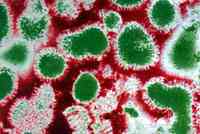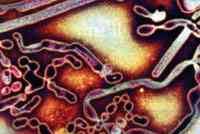Although the avian influenza A virus typically does not infect humans, since 1997 there have been numerous cases of humans infected with avian influenza viruses; these cases often result from direct contact with infected poultry or contaminated surfaces (soil, water).
Conditions for Avian Influenza Pandemic Outbreak
 |
|
H5N1 Virus |
There is still much unknown about the effects of virus subtypes and strains of avian influenza on humans, such as how low pathogenic and high pathogenic strains affect human health differently.
Due to the significant potential for human infection, health authorities must closely monitor the outbreaks of avian influenza in humans. Human infections with avian influenza A virus have been identified since 1997, but no cases of human-to-human transmission have occurred; however, since avian influenza A virus has the potential to mutate and spread easily, monitoring the transmission patterns among humans is critical.
As of now, the transmission of H5N1 virus from human to human remains rare and has not exceeded one person. Scientists are concerned that one day H5N1 could mutate to spread easily from person to person, especially given that few or no antibodies are created to provide protection, potentially leading to a pandemic.
Overview of Human Avian Influenza Infections
Confirmed cases of avian influenza virus infections in humans since 1997:
– In 1997, in the Special Administrative Region of Hong Kong, the H5N1 avian influenza A virus infected both poultry and humans. This was the first known case of direct transmission of avian influenza A virus from birds to humans.
During this outbreak, 18 people were hospitalized, and 6 died. To control the outbreak, authorities in Hong Kong culled approximately 1.5 million chickens to eliminate the source of infection. Scientists confirmed that the virus primarily spread from birds to humans and that human-to-human transmission was rare.
– In 1999, in China and Hong Kong, low pathogenic H9N2 avian influenza was found in 2 children, causing uncomplicated influenza. Both patients recovered with no further cases reported.
 |
|
Type A Virus |
The source of infection remains unclear, but there is evidence that poultry is the main source of transmission, with the primary mode of transmission being from birds to humans. However, the potential for human-to-human transmission cannot be ruled out. Several other H9N2 infections in humans were reported in China during 1998-1999.
– In 2002, in Virginia (USA), following an outbreak of H7N2 in poultry, evidence of H7N2 infection was found through serological testing in one individual.
– In 2003, again in China and Hong Kong, two cases of high pathogenic H5N1 infection occurred in two family members from Hong Kong who had traveled to China. One person recovered, while the other died. The mode of infection for these individuals remains undetermined. Another family member died of respiratory illness in China but was not tested.
– In 2003, in the Netherlands, an outbreak of H7N7 avian influenza occurred in several farms. 89 people were confirmed to have contracted H7N7 virus in conjunction with the poultry outbreak. Most cases involved poultry farmers. 78 cases experienced conjunctivitis, while 5 cases exhibited conjunctivitis along with flu-like symptoms such as cough, fever, and muscle aches; 2 cases showed only flu-like symptoms…
Among the 89 cases, 1 person died, a veterinarian who visited a farm with avian influenza, showing signs of acute respiratory syndrome. Most patients were due to direct contact with infected poultry, but Dutch authorities reported that there may have been 3 cases of transmission from poultry farmers to family members. Since then, no further reports of human-to-human H7N7 transmission have been documented.
– In 2003, a child was confirmed to have a low pathogenic H9N2 infection in Hong Kong; the child was hospitalized and has since recovered.
– In 2003, a patient was identified in New York with respiratory symptoms, initially suspected to be H1N1, but later confirmed to be infected with avian influenza A H7N2 from poultry.
– In 2004, several poultry farmers in Canada contracted high pathogenic H7N3 avian influenza in conjunction with an outbreak in poultry, but the illness caused by H7N3 only presented mild symptoms, such as conjunctival infection.
– In 2004 and 2005, there were multiple outbreaks of high pathogenic H5N1 avian influenza in Thailand, Vietnam, and many other areas in Asia, which were confirmed by the World Health Organization.
What are the symptoms of avian influenza in humans? Symptoms can range from flu-like symptoms (fever, cough, sore throat, muscle pain) to conjunctivitis (conjunctival inflammation), pneumonia, acute respiratory distress, viral pneumonia, and many other severe life-threatening complications.
How effective are current antiviral medications for influenza? Four antiviral medications: amantadine, rimantadine, oseltamivir, and zanamivir have been approved by the U.S. Food and Drug Administration (FDA) for treating influenza, with three of them recognized for prevention. All four medications are effective against avian influenza A viruses.
However, sometimes influenza virus strains can become resistant to these medications, meaning they are not always effective. For instance, analyses of some H5N1 viruses isolated from both poultry and humans in Asia have shown that the virus has developed resistance to both amantadine and rimantadine. Monitoring of drug-resistant avian influenza A viruses is ongoing.


















































